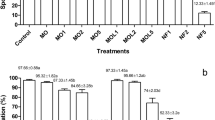Abstract
Fusarium oxysporum Schlecht. f.sp. orthoceras (Appel & Wollenw.) Bilai, a potential biocontrol agent against Orobanche cumana Wallr.,was formulated into two granular forms, wheatflour kaolin (`Pesta') granules and sodium alginatepellets. The formulations were compared in terms ofeffectiveness for mitigating O. cumanaparasitism in sunflower and shelf-life forstorage. `Pesta' granules reduced the emergence of O. cumana shoots by 64% while sodium alginatepellets did not reduce the emergence rate but increased thepercentage of diseased O. cumana plants.Calculated efficacy of the application was better for`Pesta' granules. Viability of the formulatedmaterial tested in the laboratory was higher in sodium alginatepellets than in the `Pesta' formulation.However, a loss of virulence after six months of storage wasalso observed in sodium alginate pellets in agreenhouse experiment.
Similar content being viewed by others
References
Bedi, J.S., 1994. Further studies on control of sunflower broomrape with Fusarium oxysporumf.sp. orthoceras-a potential mycoherbicide. In: A.H. Pieterse, J.A.C. Verkleij and S.J. ter Borg (eds), Proc. 3rd Int. Workshop onOrobanche and RelatedStriga Research. Royal Tropical Institute, Amsterdam, the Netherlands. pp. 539–544.
Connick, W.J. Jr, C.D. Boyette and J.R. McAlpine, 1991. Formulation of mycoherbicides using a pasta-like process. Biological Control.1: 281–287.
Connick, W.J. Jr, D.J. Daigle, C.D. Boyette, K.S. Williams, B.T. Vinyard and P.C. Jr Quimby, 1996. Water activity and other factors that affect the viability of Colletotrichum truncatumconidia in wheat flour-kaolin granules ('Pesta'). Biocontrol Science & Technology6: 277–284.
Gomez, K.A. and A.A. Gomez, 1984. Statistical Procedures for Agricultural Research. John Wiley & Sons, New York.
Hebbar, K.P., R.D. Lumsden, J.A. Lewis, S.M. Poch and B.A. Bailey, 1998. Formulation of mycoherbicidal strains of Fusarium oxysporum. Weed Science.46: 501–507.
Lumsden, R.D., J.F. Walter and C.P. Baker, 1996. Development of Gliocladium virensfor damping-off disease control. Canadian Journal of Plant Pathology.18: 463–468.
Müller-Stöver, D., 2001. Possibilities of biological control of Orobanche crenataand O. cumanawith Ulocladium botrytisand Fusarium oxysporumf.sp. orthoceras. Ph.D. dissertation, University of Hohenheim, Germany.
Müller-Stöver, D., J. Kroschel and J. Sauerborn, 2001. Viability of different propagules of Fusarium oxysporumf.sp. orthocerasduring the formulation into wheat flour-kaolin granules. In: Formulation of microbial inoculants. COST Action 830, Proceedings of a meeting held in Braunschweig, February 5-6, 1999. pp. 83–90.
Müller-Stöver, D., J. Kroschel, H. Thomas and J. Sauerborn, 2002. Chlamydospores of Fusarium oxysporumSchlecht f.sp. orthoceras(Appel & Wollenw.) Bilai as inoculum for wheat flour-kaolin granules to be used for the biological control of Orobanche cumanaWallr. European Journal of Plant Pathology.108: 221–228.
Nirenberg, H.I., 1976. Untersuchungen über die morphologische und biologische Differenzierung in del Fusarium-Sektion Liseola. Mitteilung Biologische Bundesanstalt für Landund Forstwirtschaft, Berlin-Dahlem.169: 1–117.
Parker, C., 1994.The present state of the Orobancheproblem. In: A.H. Pieterse, J.A.C. Verkleij and S.J. ter Borg eds), Proc. 3rd Int. Workshop onOrobanche iand RelatedStriga Research. Royal Tropical Institute, Amsterdam, Netherlands. pp. 32–441.
Shabana, Y.M., D. Müller-Stöver and J. Sauerborn, 2003. Granular Pesta formulation of Fusarium oxysporumf.sp. orthocerasfor biological control of sunflower broomrape: efficacy and shelf life. Biological Control.26: 189–201.
Thomas, H., J. Sauerborn, D. Müller-Stöver, A. Ziegler, J.S. Bedi and J. Kroschel, 1998. The potential of Fusarium oxysporumf.sp. orthocerasas a biological control agent for Orobanche cumanain sunflower. Biological Control.13: 41–48.
Walker, H.L. and W.J. Jr Connick, 1983. Sodium alginate for production and formulation of mycoherbicides. Weed Science.3: 333–338.
Weidemann, G.J., C.D. Boyette and G.E. Templeton, 1995. Utilization criteria for mycoherbicides. In: F.R. Hall and J.W. Barry (eds), Biorational Pest Control Agents. ACS Symposium Series, Washington, DC. pp. 238–251.
Author information
Authors and Affiliations
Corresponding author
Rights and permissions
About this article
Cite this article
Müller-Stöver, D., Thomas, H., Sauerborn, J. et al. Two granular formulations of Fusarium oxysporum f.sp. orthoceras to mitigate sunflower broomrape Orobanche cumana . BioControl 49, 595–602 (2004). https://doi.org/10.1023/B:BICO.0000036438.66150.21
Issue Date:
DOI: https://doi.org/10.1023/B:BICO.0000036438.66150.21




